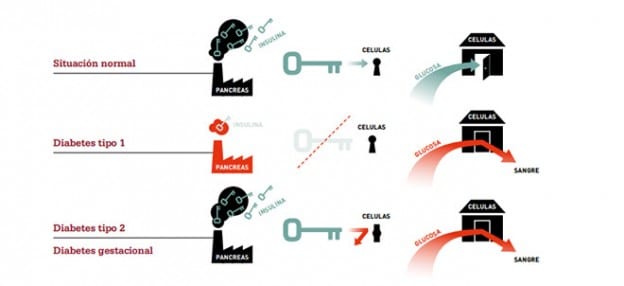
First of all, there are various types of diabetes mellitus, which is an autoimmune disease affecting the pancreas. What exactly happens is that the immune system labels the pancreatic tissue as foreign and chooses to destroy it in a way that renders it useless. Following this degenerative process, the pancreas loses its ability to produce the insulin hormone and, as a result, the blood glucose level rises.
Diabetes mellitus type 1, causes, symptoms and treatment
The cause of the type 1 diabetes mellitusHowever, what has been detected is that, if measures are not taken in advance, this can lead to vascular problems and even put the patient's life at serious risk. Insulin is an essential element for the correct functioning of our organism.
Some medical studies have linked the type 1 diabetes mellitus with other pathologies such as cholesterol above the recommended levels, cardiovascular diseases or arterial hypertension. It has even been established that women with children born weighing more than 4.5 kg are much more likely to develop type I diabetes mellitus in subsequent years. The treatment of diabetes mellitus is a medical method that is considered to be one of the most effective methods of treatment. autoimmune treatments and is adapted according to the type of diabetes mellitus and the conditions of the patient.
Symptoms include increased thirst and hunger, increased frequency of urination, irritability, blurred vision, unexplained weight loss, or feeling tired or weak.
Diabetes mellitus type 2, causes, symptoms and treatment
In the case of the type 2 diabetes mellitus It should be emphasised that it occurs more frequently in people over 30 years of age, although the number of diagnoses in children is increasing. It is the most frequent type and usually appears in obese or overweight people, and does not usually require insulin treatment since the onset of the disease.
The causes of type 2 diabetes mellitus are sedentary lifestyles and a diet high in fat and sugar.. Symptoms include frequent urination, sores that are slow to heal, areas of darkened skin, increased thirst and hunger.
Main differences between type 1 diabetes mellitus and type 2 diabetes mellitus
The main differences between the two types of diabetes mellitus are the origin of the disease, as in the case of diabetes mellitus the origin of the disease is the type 1 diabetes mellitus the cause is not well determined, whereas in the type 2 diabetes mellitus may be associated with a sedentary lifestyle or an inadequate diet. In terms of symptoms, while both are associated with increased thirst and hunger and increased frequency of urination, type 1 diabetes mellitus is associated with irritability and tiredness, while type 2 is accompanied by slow-healing sores and areas of darkened skin.
Diabetes mellitus type 3, causes, symptoms and treatment
Diabetes mellitus type 3 has been used as a theoretical concept to refer to families, friends and partners living with a person with diabetes. There is often a tendency towards overprotection and authoritarianism that helps the patient. On the contrary, a positive environment is required.
At Biosalud Day Hospital we specialise in the treatments of both diabetes mellitusIf you suffer from the above symptoms, it is recommended that you make an appointment with one of our medical experts in autoimmune diseases or request more information by e-mail or phone call.
External sources

